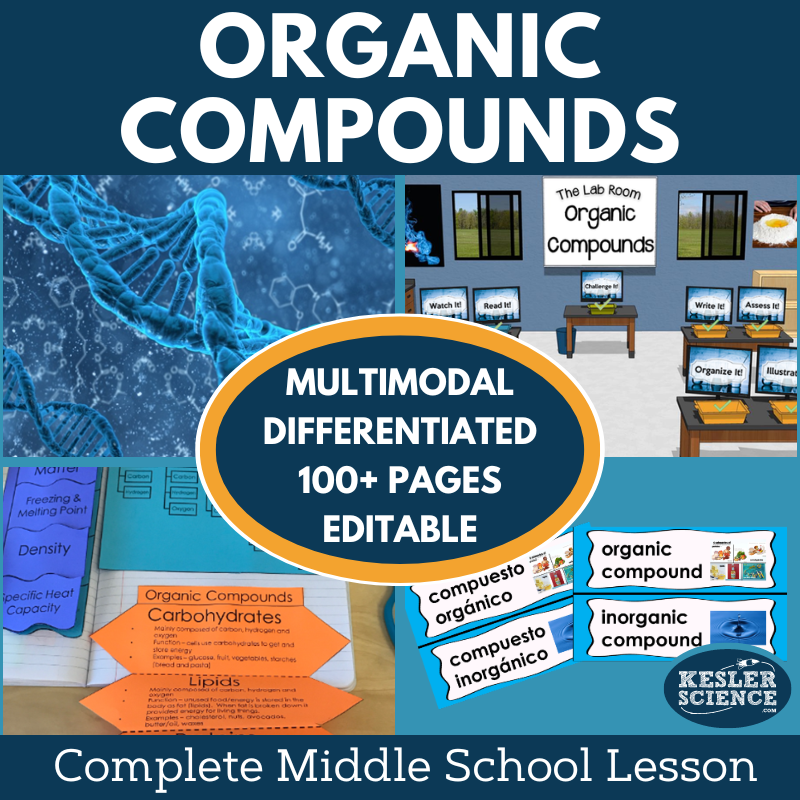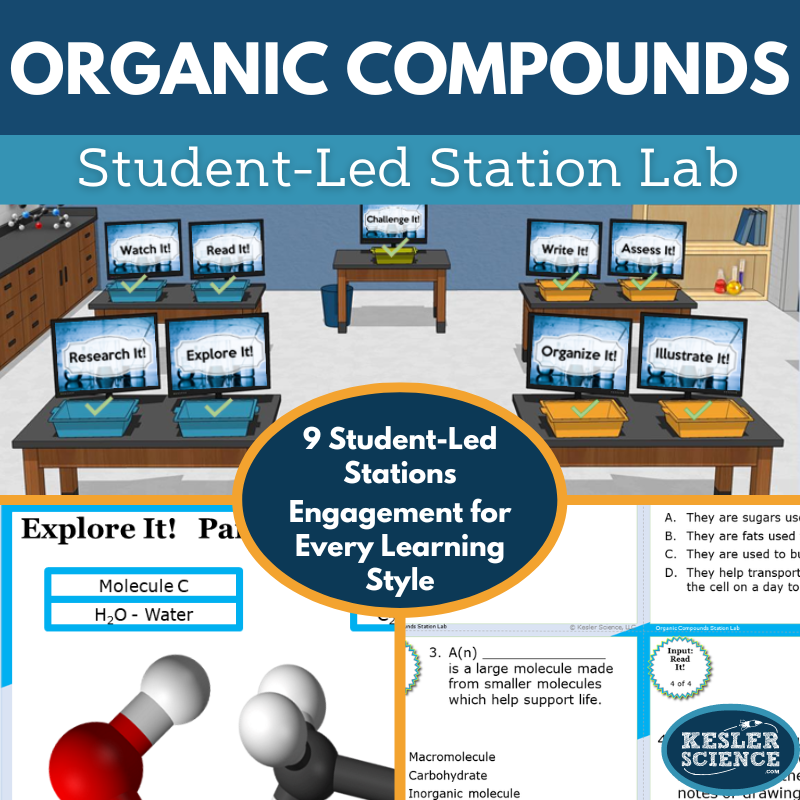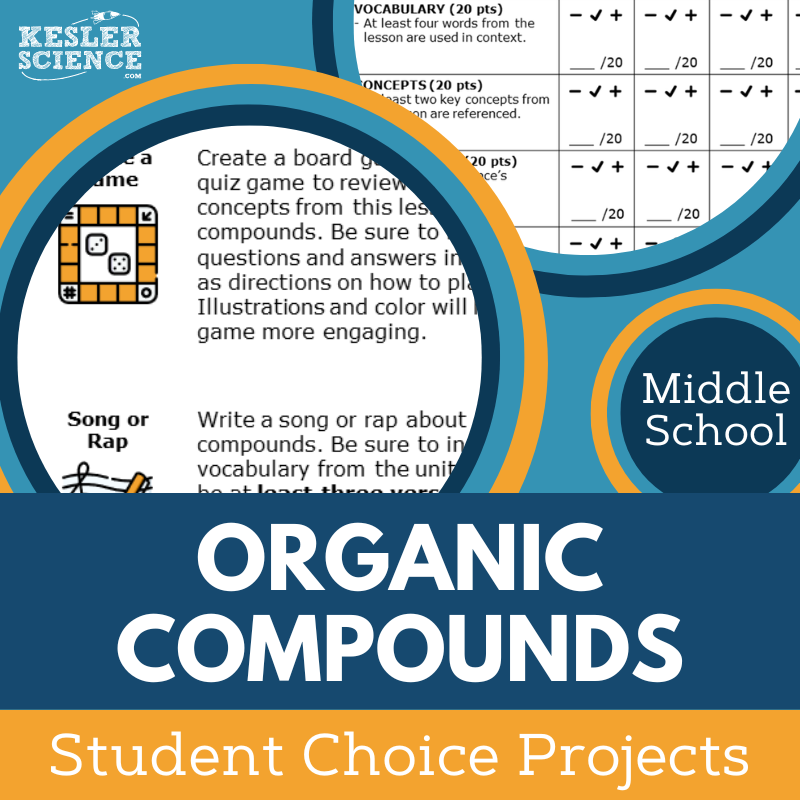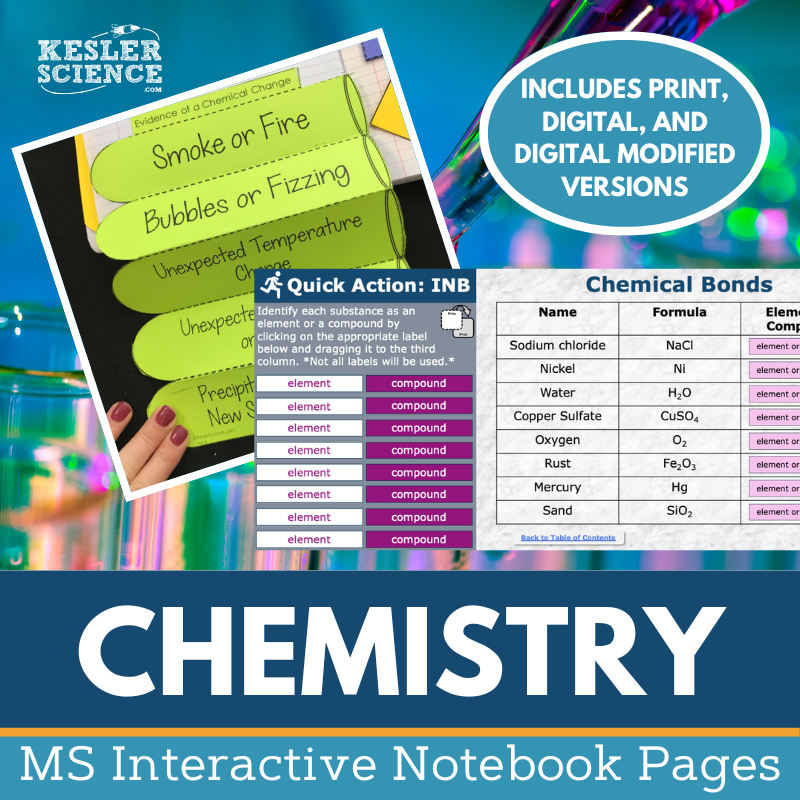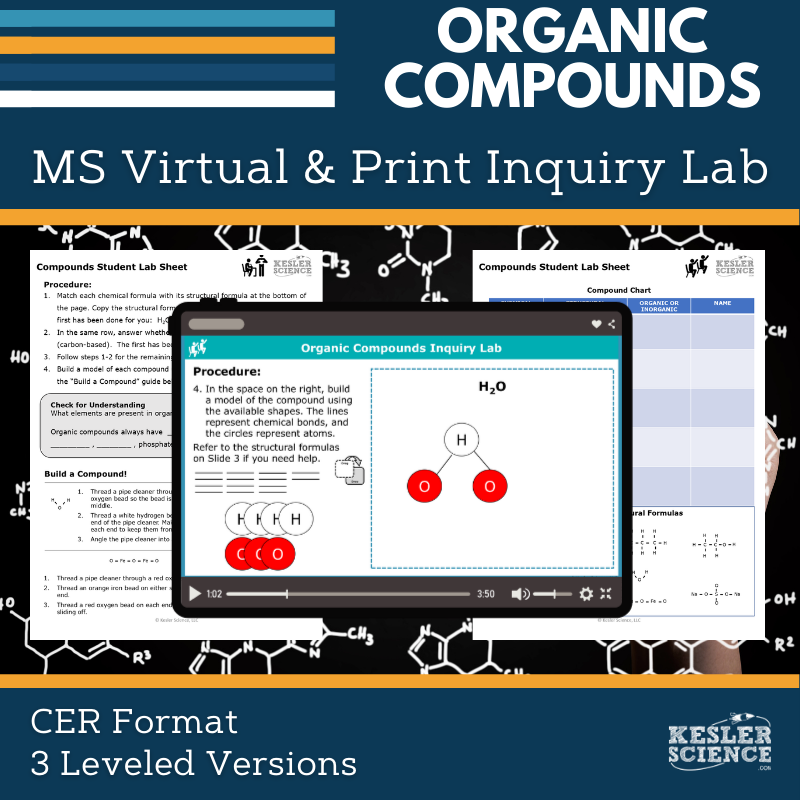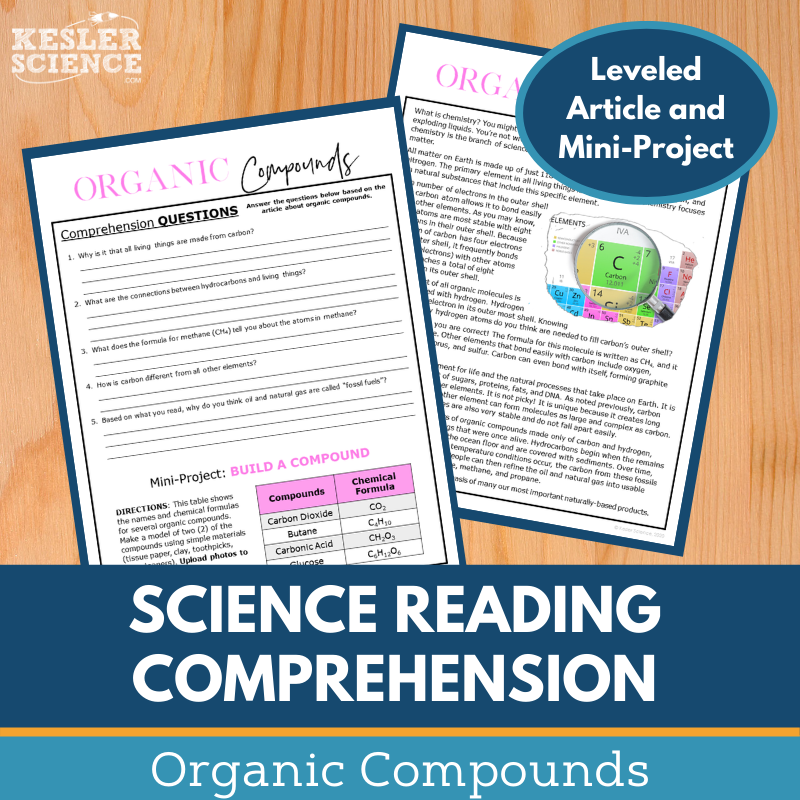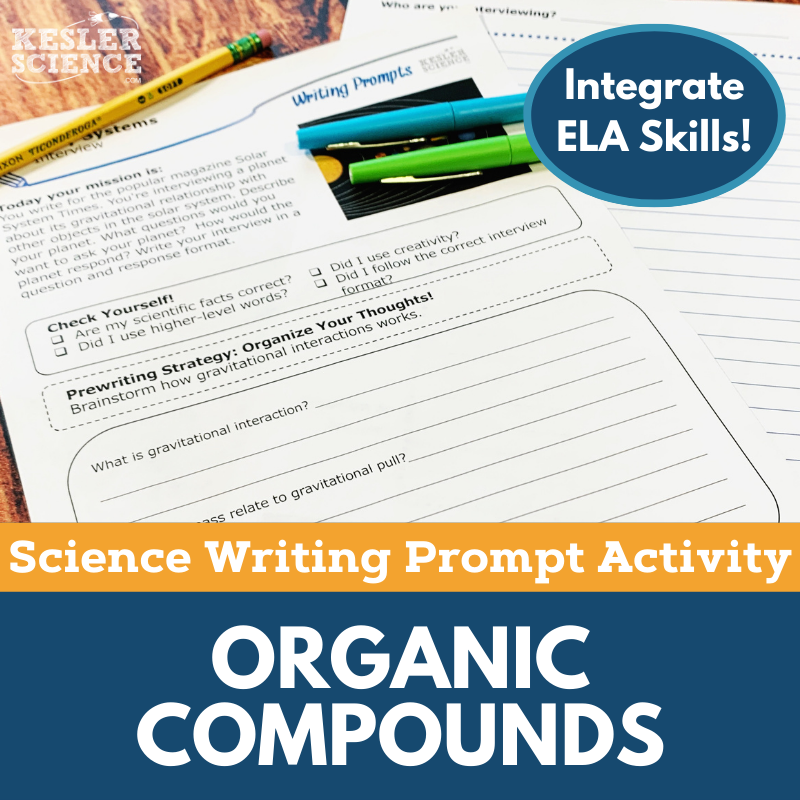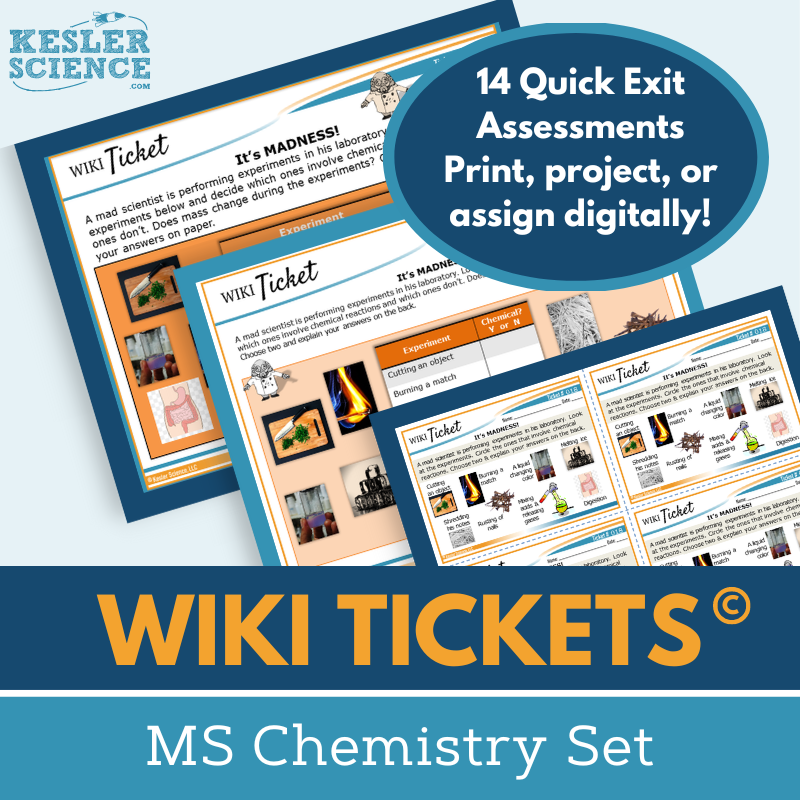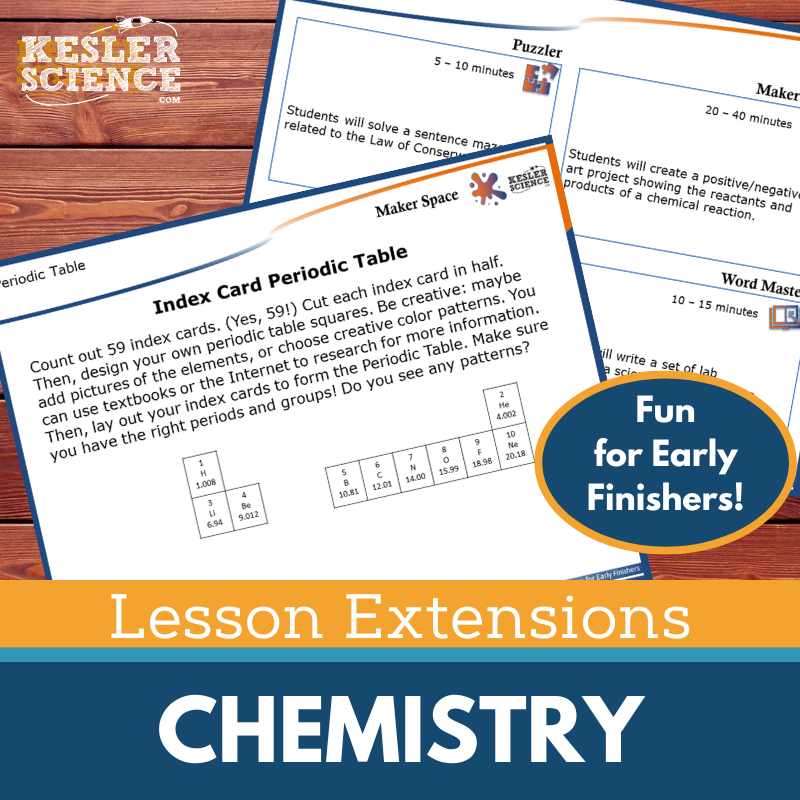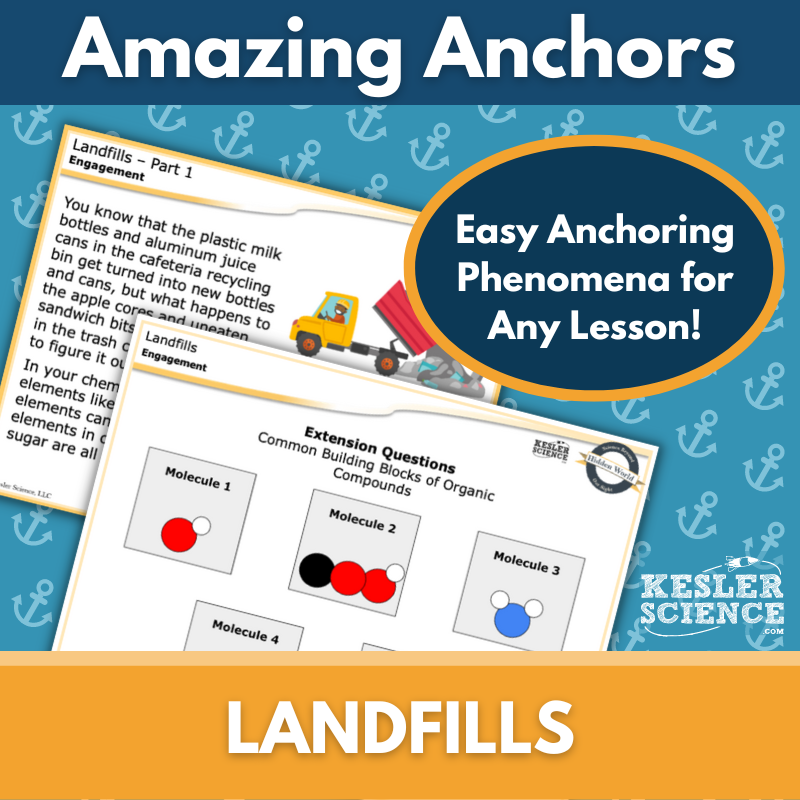Organic Compounds Activities for Middle School Science
The Kesler Science Organic Compounds resources provide comprehensive, student-centered lessons and activities that explore the identification, production, and elements of organic compounds. The resources below will give students a comprehensive understanding of organic compounds. All of the following materials are also included in the Kesler Science Membership.
The Kesler Science Organic Compounds Complete 5E Lesson offers a multi-day, student-led learning experience that covers essential questions about organic compounds, such as how to identify them, how they are produced, and the elements they contain. With minimal prep time and differentiated materials, this lesson allows teachers to focus on student success through engaging, multimodal activities in both printable and digital formats.
The lesson follows the 5E Model, which includes Engagement, Exploration, Explanation, Elaboration, and Evaluation. Students engage with content through nine differentiated stations, where they explore organic compounds through activities like experiments, reading comprehension, research tasks, and videos. They then demonstrate their understanding through output stations such as writing, organizing, and illustrating models.
This flexible resource can be used in both classroom and virtual learning environments, offering editable PowerPoints, interactive notebooks, and Spanish translations to support diverse learners. Extension activities for early finishers and various assessment options ensure that all students are challenged and supported throughout the unit.
The Kesler Science Organic Compounds Complete 5E Lesson offers a multi-day, student-led learning experience that covers essential questions about organic compounds, such as how to identify them, how they are produced, and the elements they contain. With minimal prep time and differentiated materials, this lesson allows teachers to focus on student success through engaging, multimodal activities in both printable and digital formats.
The lesson follows the 5E Model, which includes Engagement, Exploration, Explanation, Elaboration, and Evaluation. Students engage with content through nine differentiated stations, where they explore organic compounds through activities like experiments, reading comprehension, research tasks, and videos. They then demonstrate their understanding through output stations such as writing, organizing, and illustrating models.
This flexible resource can be used in both classroom and virtual learning environments, offering editable PowerPoints, interactive notebooks, and Spanish translations to support diverse learners. Extension activities for early finishers and various assessment options ensure that all students are challenged and supported throughout the unit.
The Kesler Science Organic Compounds Station Lab offers a dynamic, modular learning experience for middle school students, with eight differentiated activities designed to help them explore organic compounds and develop molecular models. With a student-centered, inquiry-based approach, this station lab allows learners to direct their own learning, while teachers facilitate the process.
The nine stations provide multimodal ways to engage with new concepts, including hands-on demonstrations, research tasks, reading comprehension, videos, and more. Students can interact with materials digitally or physically, depending on the station, and the lab also features a challenge station for early finishers to expand their learning.
These station labs are fully equipped with task cards, signage, resources, and activities for both in-person and virtual environments. The stations cover input activities like reading and watching videos, as well as output tasks such as illustrating models, writing responses, and assessing knowledge through tasks and reflection.
The Kesler Science Organic Compounds Station Lab offers a dynamic, modular learning experience for middle school students, with eight differentiated activities designed to help them explore organic compounds and develop molecular models. With a student-centered, inquiry-based approach, this station lab allows learners to direct their own learning, while teachers facilitate the process.
The nine stations provide multimodal ways to engage with new concepts, including hands-on demonstrations, research tasks, reading comprehension, videos, and more. Students can interact with materials digitally or physically, depending on the station, and the lab also features a challenge station for early finishers to expand their learning.
These station labs are fully equipped with task cards, signage, resources, and activities for both in-person and virtual environments. The stations cover input activities like reading and watching videos, as well as output tasks such as illustrating models, writing responses, and assessing knowledge through tasks and reflection.
The Kesler Science Organic Compounds Student Choice Projects provide middle school students with a variety of creative, student-led project options, allowing them to choose the format that best suits their learning style. With nine options on the choice board and the ability to "design your own" project, students have the freedom to showcase their knowledge in ways that resonate with them.
The projects are designed with flexibility in mind, featuring editable rubrics that assess vocabulary, concepts, presentation, clarity, and accuracy. Teachers can adjust the rubric to meet specific grading needs and use the projects for differentiated instruction, catering to students who need remediation or additional challenges.
Materials for the projects are simple and utilize common classroom supplies, such as paper, markers, and scissors. Many projects can be completed digitally, with crafting supplies available for hands-on model building when necessary.
The Kesler Science Organic Compounds Student Choice Projects provide middle school students with a variety of creative, student-led project options, allowing them to choose the format that best suits their learning style. With nine options on the choice board and the ability to "design your own" project, students have the freedom to showcase their knowledge in ways that resonate with them.
The projects are designed with flexibility in mind, featuring editable rubrics that assess vocabulary, concepts, presentation, clarity, and accuracy. Teachers can adjust the rubric to meet specific grading needs and use the projects for differentiated instruction, catering to students who need remediation or additional challenges.
Materials for the projects are simple and utilize common classroom supplies, such as paper, markers, and scissors. Many projects can be completed digitally, with crafting supplies available for hands-on model building when necessary.
The Kesler Science Chemistry Interactive Notebook Bundle provides an engaging way for students to explore chemistry concepts through interactive activities. Designed for both traditional classrooms and digital learning environments, this bundle includes print and digital versions, making it versatile for in-person, 1:1, or distance learning settings.
Topics covered include acids and bases, atoms, balancing chemical equations, chemical bonds, physical and chemical changes, the periodic table, properties of water, and more. The digital version features a unique PowerPoint interactive notebook that can be uploaded to platforms like Google Slides, MS Teams, or Schoology. It includes reflection pages, note-taking space, a teacher answer key, and a modified version for students needing accommodations.
The paper version offers blank templates for student interaction, pre-filled options for modified learners or absentees, and visual examples for guidance. This resource is ideal for fostering hands-on and digital engagement in middle school chemistry.
The Kesler Science Chemistry Interactive Notebook Bundle provides an engaging way for students to explore chemistry concepts through interactive activities. Designed for both traditional classrooms and digital learning environments, this bundle includes print and digital versions, making it versatile for in-person, 1:1, or distance learning settings.
Topics covered include acids and bases, atoms, balancing chemical equations, chemical bonds, physical and chemical changes, the periodic table, properties of water, and more. The digital version features a unique PowerPoint interactive notebook that can be uploaded to platforms like Google Slides, MS Teams, or Schoology. It includes reflection pages, note-taking space, a teacher answer key, and a modified version for students needing accommodations.
The paper version offers blank templates for student interaction, pre-filled options for modified learners or absentees, and visual examples for guidance. This resource is ideal for fostering hands-on and digital engagement in middle school chemistry.
The Kesler Science Organic Compounds Inquiry Lab aligns with NGSS by helping students model chemical compounds and distinguish between organic and inorganic substances. Students use structural and chemical formulas to build models and identify additional elements found in organic compounds. They can either research compound names or use a teacher-provided list, supporting both guided and independent learning.
This lab is offered in both hands-on print and interactive digital formats, each including comprehension questions, Claim-Evidence-Reasoning (C.E.R.) prompts, and a reflection section. Differentiation is built in with three versions: a modified format for learners needing support, an on-level version with guided inquiry, and an independent version for advanced students. The print version uses materials like pony beads and pipe cleaners for building models, while the digital version is fully interactive with no materials needed.
Teacher resources include editable PowerPoints, Google Slides compatibility, answer keys, and detailed teacher pages outlining prep time, standards, and procedures. This lab provides maximum flexibility and supports multimodal learning to keep middle school students engaged and thinking critically about chemistry.
The Kesler Science Organic Compounds Inquiry Lab aligns with NGSS by helping students model chemical compounds and distinguish between organic and inorganic substances. Students use structural and chemical formulas to build models and identify additional elements found in organic compounds. They can either research compound names or use a teacher-provided list, supporting both guided and independent learning.
This lab is offered in both hands-on print and interactive digital formats, each including comprehension questions, Claim-Evidence-Reasoning (C.E.R.) prompts, and a reflection section. Differentiation is built in with three versions: a modified format for learners needing support, an on-level version with guided inquiry, and an independent version for advanced students. The print version uses materials like pony beads and pipe cleaners for building models, while the digital version is fully interactive with no materials needed.
Teacher resources include editable PowerPoints, Google Slides compatibility, answer keys, and detailed teacher pages outlining prep time, standards, and procedures. This lab provides maximum flexibility and supports multimodal learning to keep middle school students engaged and thinking critically about chemistry.
The Kesler Science Organic Compounds Reading Comprehension activity engages middle school students by exploring the structure of organic compounds, which contain carbon and other elements. Students read a nonfiction article, answer comprehension questions, and create models of two organic compounds using household items. This hands-on mini-project reinforces their understanding of organic compounds in an interactive way.
With leveled reading passages appropriate for grades 6-8, the activity encourages science literacy and enhances reading comprehension. The materials include 5-7 questions for each passage, along with a Cornell notes template and colorful graphics that are easily printable. It is also designed for virtual learning, making it accessible through platforms like Google Classroom, MS Teams, Schoology, and Canvas.
This reading comprehension activity is ideal for various instructional needs, including supporting absent students, extra credit, and sub plans. Teachers can use it to build science literacy, improve textual analysis, or create engaging class discussions, offering a versatile and effective learning resource.
The Kesler Science Organic Compounds Reading Comprehension activity engages middle school students by exploring the structure of organic compounds, which contain carbon and other elements. Students read a nonfiction article, answer comprehension questions, and create models of two organic compounds using household items. This hands-on mini-project reinforces their understanding of organic compounds in an interactive way.
With leveled reading passages appropriate for grades 6-8, the activity encourages science literacy and enhances reading comprehension. The materials include 5-7 questions for each passage, along with a Cornell notes template and colorful graphics that are easily printable. It is also designed for virtual learning, making it accessible through platforms like Google Classroom, MS Teams, Schoology, and Canvas.
This reading comprehension activity is ideal for various instructional needs, including supporting absent students, extra credit, and sub plans. Teachers can use it to build science literacy, improve textual analysis, or create engaging class discussions, offering a versatile and effective learning resource.
The Kesler Science Organic Compounds Science Writing Prompt Activity allows middle school students to test their understanding of organic compounds through a fun and engaging vocabulary story format. This creative approach helps students strengthen both their science reasoning and writing skills. The activity is designed for flexibility, with materials that support in-person and virtual learning environments.
The activity is aligned with TEKS and NGSS standards, making it a valuable tool for cross-curricular instruction, pre-test assessments, and differentiation. It includes teacher directions, rubrics, and editable digital versions for easy integration into any classroom setting. Students can use the full-sized or half-sheet handouts, or complete the assignment digitally, ensuring accessibility for all learners.
Whether used for elaboration, extra credit, or make-up work, this writing prompt is a low-prep, high-quality resource that encourages critical thinking and student engagement. It can also serve as a TELPAS sample or be customized for different student needs, making it a versatile tool for promoting science literacy and writing development.
The Kesler Science Organic Compounds Science Writing Prompt Activity allows middle school students to test their understanding of organic compounds through a fun and engaging vocabulary story format. This creative approach helps students strengthen both their science reasoning and writing skills. The activity is designed for flexibility, with materials that support in-person and virtual learning environments.
The activity is aligned with TEKS and NGSS standards, making it a valuable tool for cross-curricular instruction, pre-test assessments, and differentiation. It includes teacher directions, rubrics, and editable digital versions for easy integration into any classroom setting. Students can use the full-sized or half-sheet handouts, or complete the assignment digitally, ensuring accessibility for all learners.
Whether used for elaboration, extra credit, or make-up work, this writing prompt is a low-prep, high-quality resource that encourages critical thinking and student engagement. It can also serve as a TELPAS sample or be customized for different student needs, making it a versatile tool for promoting science literacy and writing development.
The Kesler Science Chemistry WIKI Tickets provide a flexible and engaging way to assess 6th-8th grade students’ understanding of key science topics. Aligned with NGSS and TEKS standards, these formative assessments are designed for both in-person and virtual learning environments. Each of the 14 topics includes multiple formats: a display version for projection, three printable handout sizes, and interactive digital files available as editable PowerPoint or Google Slides. A bonus table of contents ensures clear alignment with standards, and all topics include at least one ticket, with some offering more.
WIKI Tickets, standing for "What I Know Is," can serve as exit tickets, bellringers, or quick checks for understanding. Students can respond digitally or on paper, depending on the setting. Topics such as atomic structure, density, chemical reactions, and periodic table arrangement are covered, offering a comprehensive approach to middle school chemistry.
The Kesler Science WIKI Tickets are colorful, versatile, and designed to meet the demands of any learning scenario. Whether in a classroom or remote setting, these assessments provide a fun and meaningful way to gauge student progress while keeping them engaged.
The Kesler Science Chemistry WIKI Tickets provide a flexible and engaging way to assess 6th-8th grade students’ understanding of key science topics. Aligned with NGSS and TEKS standards, these formative assessments are designed for both in-person and virtual learning environments. Each of the 14 topics includes multiple formats: a display version for projection, three printable handout sizes, and interactive digital files available as editable PowerPoint or Google Slides. A bonus table of contents ensures clear alignment with standards, and all topics include at least one ticket, with some offering more.
WIKI Tickets, standing for "What I Know Is," can serve as exit tickets, bellringers, or quick checks for understanding. Students can respond digitally or on paper, depending on the setting. Topics such as atomic structure, density, chemical reactions, and periodic table arrangement are covered, offering a comprehensive approach to middle school chemistry.
The Kesler Science WIKI Tickets are colorful, versatile, and designed to meet the demands of any learning scenario. Whether in a classroom or remote setting, these assessments provide a fun and meaningful way to gauge student progress while keeping them engaged.
The Kesler Science Chemistry Lesson Extensions offer an engaging solution for keeping fast finishers motivated and learning. By incorporating activities that challenge critical thinking and creativity, these extensions are ideal for filling downtime during testing, curbing distractions, and wrapping up lessons. They provide rigorous yet enjoyable opportunities for students ready to delve deeper into NGSS and TEKS chemistry standards.
Each Lesson Extension includes four creative activities designed to enrich the learning experience. The Puzzler improves problem-solving skills through relevant puzzles, while the Maker Space integrates STEAM connections with hands-on projects. The Tech Connection allows students to demonstrate their learning through digital media, and the Word Master brings creative writing into the science classroom. Teachers are supported with clear directions, answer keys, and resources available in both projection and print-friendly formats.
This bundle covers essential topics such as the periodic table, chemical reactions, synthetic materials, and atomic structures. These versatile tools provide high-level supplementary materials to challenge independent learners and offer a meaningful way to conclude chemistry lessons with engagement and purpose.
The Kesler Science Chemistry Lesson Extensions offer an engaging solution for keeping fast finishers motivated and learning. By incorporating activities that challenge critical thinking and creativity, these extensions are ideal for filling downtime during testing, curbing distractions, and wrapping up lessons. They provide rigorous yet enjoyable opportunities for students ready to delve deeper into NGSS and TEKS chemistry standards.
Each Lesson Extension includes four creative activities designed to enrich the learning experience. The Puzzler improves problem-solving skills through relevant puzzles, while the Maker Space integrates STEAM connections with hands-on projects. The Tech Connection allows students to demonstrate their learning through digital media, and the Word Master brings creative writing into the science classroom. Teachers are supported with clear directions, answer keys, and resources available in both projection and print-friendly formats.
This bundle covers essential topics such as the periodic table, chemical reactions, synthetic materials, and atomic structures. These versatile tools provide high-level supplementary materials to challenge independent learners and offer a meaningful way to conclude chemistry lessons with engagement and purpose.
The Amazing Anchors Phenomenon Lesson introduces and reinforces organic compounds through a real-world connection to landfills. The resource begins with an engaging introductory reading that explores how organic materials break down in landfills, followed by comprehension and extension questions that prompt students to think critically and make predictions.
An explanatory reading follows, clearly breaking down the science behind organic compounds in a student-friendly way. Additional comprehension and reinforcement questions help students deepen their understanding of the topic. The resource includes a modified version with differentiated language and sentence starters to support a range of learners.
This no-prep resource includes teacher directions, answer keys, editable materials, and both print and digital formats for flexible classroom use. It also comes with projection slides and various handout sizes, making it ideal for interactive notebooks. Designed to bookend any science lesson, these materials support the Engagement and Elaborate phases of the 5E model.
The Amazing Anchors Phenomenon Lesson introduces and reinforces organic compounds through a real-world connection to landfills. The resource begins with an engaging introductory reading that explores how organic materials break down in landfills, followed by comprehension and extension questions that prompt students to think critically and make predictions.
An explanatory reading follows, clearly breaking down the science behind organic compounds in a student-friendly way. Additional comprehension and reinforcement questions help students deepen their understanding of the topic. The resource includes a modified version with differentiated language and sentence starters to support a range of learners.
This no-prep resource includes teacher directions, answer keys, editable materials, and both print and digital formats for flexible classroom use. It also comes with projection slides and various handout sizes, making it ideal for interactive notebooks. Designed to bookend any science lesson, these materials support the Engagement and Elaborate phases of the 5E model.
Year-Round Resources
These year-round activities will increase your students' understanding of many middle school science topics. All of these activities are also included in the Kesler Science Membership.
Visual Data & Graphing
You're not alone if your students struggle with understanding graphs, charts, and tables. It's a skill that takes an enormous amount of practice. This resource will help students build a strong foundation in analyzing data and creating their own data visualizations.
Bell Ringers and Warm-Ups
These middle school science bell ringers are an excellent way to engage your students as soon as they walk into your classroom. This comprehensive FULL YEAR resource includes everything you need to start off each science class with an interesting warm-up activity.
Review Board Games
Each game board has been carefully designed to keep students engaged. There are 10 different action spaces on each board and dozens of question cards. All of the actions are related to science concepts and keep the students motivated throughout the game.
Each game is ready to play. Simply print out the board and the cards and let the students enjoy reviewing nine different units.
Essential Questions
Below are the essential questions associated with the lessons and activities included in this unit. This topic is only one of more than 100 middle school science topics included in the Kesler Science Membership.
-
How do you identify organic compounds?
-
How are organic compounds produced?
-
What elements are found in organic compounds?
-
How do you recognize organic compounds in chemical formulas?
Kesler Science Membership
Imagine never having to search for another middle school science lesson again. The membership gives you access to ALL of the Kesler Science products in one place (Yes, including everything above).
Say goodbye to long hours of lesson prep.

